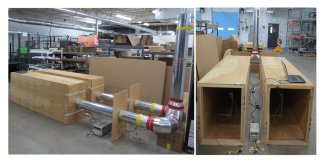A comparison of baited traps for mosquito and tick collections
Carbon dioxide traps are frequently used to bait mosquitoes during field sampling. Since NEON monitors naturally occurring CO2 in the atmosphere, sampling designs must test how mosquito traps affect CO2 sensors and implement measures to reduce or eliminate potential interference. NEON project staff conducted a performance study of combinations of three trap types, two forms of dry ice and three wind speeds to inform site and sampling design to ensure standardized and high-quality data.

Study description
NEON project staff collected data to evaluate variation in the performance of different types of CO2-baited traps used to collect blood-feeding arthropods (e.g., mosquitoes, ticks). An experimental flume apparatus was constructed in our shipping/receiving warehouse for use in data collection. NEON staff measured the performance of all combinations of three trap types, two forms of dry ice and three wind speeds by placing a trap in one end of the flume and measuring the concentration of carbon dioxide released over a period of up to 24 hours. Additionally, we measured the performance of carbon dioxide traps baited with CO2 released from compressed gas cylinders, and compared these results to the measured performance of dry ice-baited trap types.
Study methodology
Data were collected during a period from February 27, 2012 through September 28, 2012. The date and time that each datum was collected is reported as the value for the variable “Timestamp” in each of the two data files associated with this study. As indicated, the experimental flume apparatus was built in our shipping/receiving warehouse, and all data were collected at this location (latitude: 40.016511, longitude: -105.245762)
Downloadable data
Insect flume study data zip file download
Summary of recommendations
Among the three dry-ice baited trap types tested, traps involving insulated coolers are recommended. These were the only traps capable of sampling for continuous 24-hour periods when baited with 1,400g of dry ice. They were associated with a relatively low but consistent level of baiting intensity throughout the trials. This performance was matched and slightly exceeded by traps baited with carbon dioxide from compressed gas cylinders. Trials involving these traps lasted for roughly the same duration and were associated with slightly lower values of both mean and maximum baiting intensity and variation in baiting intensity during trials. However, these minor improvements do not outweigh the significant cost differential between dry ice and compressed gas carbon dioxide. Dry ice-baited insulated cooler traps clearly represent the best balance of performance and price. Further, insulated cooler traps exhibit little if any variation in performance related to dry ice form (pellet versus block) and wind speed, indicating that they are likely to provide greater standardization in the face of variation in environmental conditions and sampling supplies sometimes encountered in the field.